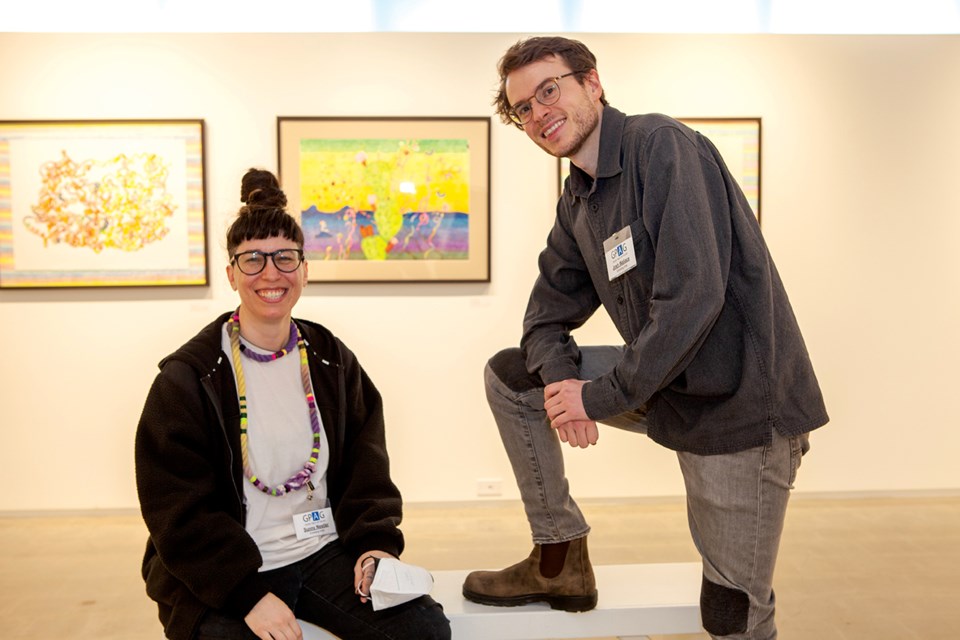Two artists whose imaginations operate at opposite extremes of physical scale—from mammoth musical engines to infinitesimal DNA strands—are exhibiting works at the Gibsons Public Art Gallery that offer original ways of sensing the world.
Josh Wallace, who moved from Ottawa to Gibsons last year, uses his architectural training to design speculative musical instruments powered by the Earth. His mixed-media show Listening Into Non-Separateness also includes acoustic visualizations that trace the shape of sounds, transforming barks of bearded seals and plucky guitar riffs into spectrographic starbursts.
The acrylic paintings and digital works by Vancouver-based artist Sunny Nestler that compose the exhibit Cone Worms and Tangled Knots depict a world of bright-coloured organic matter that writhes and mutates at the periphery of our own dimension. Nestler’s university education in biological science tethers the visions of serpentine shapes to real-world analogues that teem on seabeds or coil in abdomens.
To launch the exhibition, both artists met with the public on March 26.
For Wallace, a musician as well as an intern architect, his fantastic structures give voice to the environment. The intricate schematics for Sea Carillon and Rain Pendant situate them in familiar locales: the Davis Bay Sea Walk and the Sprockids Park forest, respectively.
“Normally, I design for housing or institutional buildings,” Wallace said. “But these [concepts] are a way of considering how architecture might produce a kind of enhanced connection to the Earth, or a kind of environmental awareness, or a stronger connection to environmental phenomena.”
Each of his accompanying sound visualization graphics is accompanied by a QR code that can be scanned to play the original audio. Clips of howling wind, cicadas and vocal thrumming compose a serial soundscape.
Wallace collaborated with Gibsons musician Greg Andersen to create the songs that multi-storey synthesizers might produce. The musical tracks will be added to the exhibit during the next week.
When it comes to describing his imagined instruments, Wallace is deliberate about taxonomy. “I like using the words listening and listening device,” he said. “I suppose they’re playing devices as well, but when you’re playing music with another person, I think the best music is made when you’re really listening to each other instead of trying to talk over each other. And I thought that that kind of relationship is potentially quite useful when thinking about climate change. It’s almost like we’re in a dance with the Earth, but maybe we need to listen.”
The works by Nestler also evoke dynamic ecosystems. In acrylic paintings like Observatory and Tangled Mountain, convoluted filaments cluster in pyramidal accumulations, pointing skyward. Viewers make their own decision about focal distance: is it a tortuous landscape, or a tangled web of genetic instructions?
“I start with observational drawing, observing things around me,” said Nestler. “And then when I’m back in my studio, I repeat those drawings over and over, seeing what they do when they’re no longer based on observation. That led me to this process where I would repeat certain objects and see how they changed over time.”
“Like DNA replication, how there’s copies of copies of copies, but then sometimes there’s these random mutations and that’s what makes evolution possible.”
Cone Worms Near Burrard Inlet, a video sequence, is one of several works that transform familiar vistas. Nestler’s prismatic career—years as a bike shop mechanic, painter, writing instructor at Emily Carr University, and digital animator—converges on a passion for discovering hidden realities.
“I see [my work] as a kind of parallel universe, overlapping forms between what exists in our natural world and what could exist in a similar natural world that we don’t actually see,” Nestler said. “That’s why I’ve started to take on some of these subjects that are a little bit more like invented creatures.”
The show includes an immersive digital experience designed by Nestler that invites viewers to study hidden three-dimensional shapes in the gallery that are revealed only when wearing a headset.
The shows by Wallace and Nestler continue until April 24.



